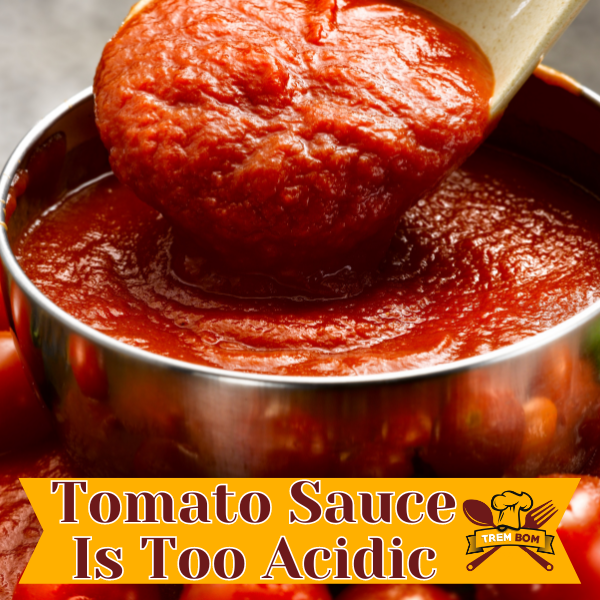
Ever faced the puckering punch of a tomato sauce that’s just too acidic, lacking in natural sweetness, and needing an alkaline ingredient to balance its flavorful profile? We’ve all been there, diving into a plate of spaghetti only to have our taste buds overwhelmed by tartness, when a teaspoon of the right ingredient could have balanced it with flavorful natural sweetness.
It’s a common kitchen conundrum that can throw off the balance of your dish when the sauce needs a hit of salt among other options. We’re here to guide you through the simple tweaks needed to mellow out that tangy bite and achieve the perfect harmony in your sauce. No more wincing or watering down—just pure, robust flavor that complements your culinary creations.
In our journey together, we’ll explore how easy it is to tame the acidity without compromising on taste. Let’s get straight into transforming your next pasta night from overly sour to outstandingly savory.
Key Takeaways
- To mitigate the acidity in tomato sauce, incorporate sweeteners like sugar or natural options such as carrots and onions, which can balance the sharpness without compromising flavor.
- Enhancing the overall flavor profile of tomato sauce can be achieved by adding herbs, spices, or fats like olive oil, which not only round out the taste but also help neutralize acidity.
- For those looking to reduce the acidic bite in their sauce, consider cooking methods such as a longer simmering time, which allows for the acid to mellow out and the flavors to deepen.
- Utilize tips like adding a pinch of baking soda to your tomato sauce; it reacts with the acidity and can make the sauce less harsh on the palate.
- When making homemade tomato sauce, select naturally sweeter tomato varieties or canned tomatoes labeled “no salt added” to ensure a less acidic base.
- Perfect your spaghetti sauce by tasting and adjusting as you cook, keeping in mind that a balanced sauce often requires a combination of sweetness, fat, and seasoning to counteract acidity.
Understanding Tomato Sauce Acidity
Acidity Factors
Tomatoes are beloved for their tangy zest, but sometimes our tomato sauce can taste too acidic. This sharpness comes from natural acids, like citric and malic acid. These compounds are found in all tomatoes, yet their levels can differ.
The soil and climate where a tomato grows play a role in its acidity. Tomatoes grown in cooler climates tend to be more tart. We also consider the variety of tomato when making sauce as some types have less acid than others.
Choosing Tomatoes
When we’re on the hunt for the perfect tomatoes for our sauce, we go for varieties known to be lower in acid. For example, yellow and orange tomatoes often make a milder sauce than red ones.
We always pick ripe, seasonal tomatoes because they’re sweeter. The color of a tomato can clue us into its acidity level—brighter hues usually mean more acid while deeper shades suggest less.
Cooking Techniques
To combat high acidity, slow cooking is our best friend. It allows flavors to develop fully and softens that harsh tanginess. Roasting is another technique we love; it brings out natural sugars which balance out the sour notes.
Simmering is key too—it breaks down those pesky acidic compounds over time so our sauce ends up rich and smooth rather than biting.
Balancing the Acidity
Alkaline Ingredients
We’ve all been there—our homemade tomato sauce tastes too acidic, and our taste buds are begging for relief. Baking soda is a secret weapon we use to neutralize that excess acid. But remember, it’s potent! We start with just a pinch and wait a moment because it can cause the sauce to foam up.
Adding sugar might seem like an old kitchen tale, but it works wonders. A small amount of sugar doesn’t make the sauce sweet; instead, it cuts through the sourness beautifully. It’s about finding that perfect balance where every flavor complements each other.
Another trick is using dairy products. Cheese or cream not only brings down acidity but also adds creamy goodness to our sauce. Imagine spooning that rich, velvety tomato sauce over pasta—the acidity forgotten amidst layers of flavor.
Incorporating Umami
Umami—it’s what gives food its savory depth and makes us go “Mmm.” To give our overly acidic tomato sauce this dimension, we often turn to mushrooms or Parmesan cheese which naturally enhance umami without adding more acid into the mix.
Sometimes we get adventurous and add anchovies or soy sauce. These ingredients deepen flavors in such an intriguing way without tipping the scale towards more acidity—a few drops of soy or one finely chopped anchovy does the job.
And let’s not forget olive oil! A drizzle can enrich our tomato sauce while smoothing out any sharp acidic notes lingering around. Plus, who doesn’t love that Mediterranean touch?
Enhancing Flavor Profile
Flavor Balancing
We know that a good tomato sauce hinges on the perfect balance of flavors. Salt is our first go-to when we need to tame the acidity. Just a pinch can make a world of difference, reducing that sharp tang and bringing out the best in tomatoes.
But it’s not just about salt. We like to play with sweet and savory elements too. A dash of sugar or a spoonful of honey helps counteract acidity, creating harmony on our palates. It’s all about finding that sweet spot where every taste complements each other.
And let’s not forget herbs – they’re true magicians! Adding basil, oregano, or thyme introduces fresh aromas and complex tastes that work together to mellow down any harsh acidic notes.
Taste Improvement
As we cook, regular taste tests are crucial for us. They help us stay on track and make necessary tweaks right away. After all, no one wants their spaghetti night ruined by an overly tart sauce!
When adjusting flavor profiles, we consider strategic ingredient additions carefully—maybe some grated carrot for subtle sweetness or a splash of cream for richness? These little touches can transform an average tomato sauce into something truly memorable.
Ultimately, we aim for rounded flavors where no single element overpowers another—especially not acidity.
Reducing Acidity in Tomato Sauce
Higher-pH Ingredients
We’ve found that balancing the acidity of tomato sauce can be as simple as adding higher-pH ingredients. One trick we often use is to incorporate root vegetables like carrots, which not only raise the pH level but also impart a mild sweetness that complements the tomatoes.
- Stir in squash or pumpkin puree for a subtle sweetness and pH increase.
- Blend in cooked onions to add both sweetness and alkalinity.
These additions are great because they enrich the sauce with nutrients while taming its tanginess. When we mix these veggies into our sauce, it becomes more than just a condiment; it’s a hearty, nutritious part of our meal.
Best Practices
To ensure our tomato sauce isn’t too acidic, we stick to best practices learned from experience and shared kitchen wisdom. We always start with proven recipes as they provide us with a solid foundation for delicious results. These time-tested methods help us avoid common pitfalls like unbalanced flavors or excessive acidity.
Consistent heat is crucial when cooking. It prevents fluctuating acidity levels that can happen if the sauce is heated unevenly or too quickly.
- Maintain consistent heat when cooking.
- Store ingredients properly to preserve their natural pH balance.
Proper storage of ingredients before making the sauce also plays an important role in preserving their natural pH balance. This way, each component brings its best flavor and proper acidity level to every batch of sauce we make.
Tips for Less Acidic Sauce
Ingredient Selection
When we make tomato sauce, choosing the right ingredients is crucial. We’ve found that fresh tomatoes can really make a difference. They tend to have less acidity than canned ones, so you start off with a milder base.
Another step we take is opting for organic produce when possible. It’s not just about being health-conscious; organic tomatoes may actually be less acidic. Plus, they often taste better too.
If our recipe calls for wine, we’re careful about which type to use. Some wines are more acidic than others. A splash of a mild white or red can enhance flavor without adding too much acid.
Cooking Adjustments
The way we cook our sauce also affects its acidity levels. We adjust the cooking time if the tomatoes taste tart—longer simmering can help mellow out the flavors.
We pay attention to the pH levels of ingredients and add them in an order that helps balance out the overall acidity of our sauce.
And sometimes, it’s not just what you cook but how you cook it. We’ve experimented with making sauces on both stovetop and oven methods to see which best reduces acidity.
Making Homemade Sauce Less Acidic
Kitchen Techniques
We’ve discovered that a smooth texture often feels less acidic on the palate. To achieve this, blending is our go-to method. It breaks down chunks, creating a homogenous sauce. We notice it’s not just about taste but also mouthfeel.
Straining seeds and skins is another trick we use. These parts of the tomato can add unwanted acidity to our sauce. By removing them, we ensure a milder flavor profile that everyone enjoys.
In our kitchen adventures, we’ve learned to always reach for wooden spoons and spatulas. Metallic utensils can react with the tomatoes, altering the taste subtly but surely.
Ingredient Tweaks
Swapping ingredients has been game-changing for us in balancing flavors. For instance, replacing some tomato paste with roasted red peppers reduces acid concentration significantly while adding a delicious twist.
Caramelized onions are another favorite addition of ours. They bring out natural sweetness and add complexity to any dish—tomato sauce included!
Lastly, instead of water, vegetable stock is our secret weapon when diluting sauces—it adds flavor without increasing acidity.
Improving Tomato Sauce Taste
Flavor Enhancements
We’ve discovered that infusing flavors during the cooking process can transform a simple tomato sauce. By adding bay leaves or basil stems while the sauce simmers, we introduce subtle yet complex aromas. Remember to remove these herbs before serving to avoid any unexpected texture in your mouthful.
After taking the sauce off the heat, a drizzle of high-quality extra virgin olive oil works wonders. It not only adds richness but also improves mouthfeel significantly. Plus, there’s something about finishing a dish with olive oil that makes us feel like true kitchen wizards.
At serving time, don’t forget to sprinkle on some freshly grated cheese. This isn’t just for show; it actually acts as a flavor buffer and gives your sauce a smoother, creamier texture. It’s amazing how such simple touches elevate our tomato sauce from good to great.
Acidity Reduction
Now let’s tackle the main challenge: when our tomato sauce is too acidic, what do we do? First off, allow your concoction to cool down slightly before making any adjustments—flavors change with temperature changes and you might find less need for tweaking than expected.
When reducing acidity, go slow and steady; reassess after each tweak because multiple small adjustments are often more effective than one large one. We’ve learned this through many taste tests!
Remember that if you reduce volume by evaporation—letting it simmer uncovered—the flavors will concentrate which means so will the acidity! So keep an eye on it and give it regular stirs.
Perfecting Spaghetti Sauce
Acidity Control
We know that the key to a great spaghetti sauce is balancing flavors. When our tomato sauce is too acidic, it can overshadow the rich and savory notes we love. So, we keep an eye on tomato ripeness before they go into our pot. The riper the tomatoes, the sweeter and less acidic they’ll be.
Sometimes, though, even ripe tomatoes need help. That’s why we’re careful with additional acidic ingredients like wine or lemon juice. We add them sparingly and taste as we go. It’s all about creating harmony in our sauce.
Cooking process matters too. If a quick taste test reveals too much tanginess early on, we adjust right away—maybe by simmering longer or adding a pinch of sugar to balance things out.
Final Touches
Once the acidity is in check, it’s time for those final tweaks that make our spaghetti sauce sing. A splash of aged balsamic vinegar works wonders if there’s still an edge that needs smoothing over; its sweetness complements without overpowering.
Before serving up this labor of love, stirring in fresh herbs gives it freshness and depth; basil or oregano are favorites among us for their aromatic lift.
And here’s a secret: letting your sauce rest overnight often softens any sharpness left behind—a perfect solution when planning ahead for tomorrow’s dinner party!
By keeping these tips in mind:
- Monitor tomato ripeness;
- Use extra acids cautiously;
- Adjust cooking based on tasting;
our spaghetti sauces will always hit just the right note on every palate.
Recipe for Balanced Tomato Sauce
Step-by-Step Guide
We start with a base of sautéed onions and garlic. This foundation adds depth to our sauce. We cook them until they’re soft and golden. It’s important not to rush this step.
Next, we gradually add the tomatoes along with other vegetables like carrots or bell peppers. These veggies help counteract the acidity in the tomatoes. We let everything simmer gently, allowing flavors to mingle.
After some time, we taste our creation carefully. Adjusting seasoning is key here—we might add a pinch of sugar or a splash of cream if needed.
Serving Suggestions
We choose pasta shapes that hold onto less acidic sauces well, such as penne or rigatoni.
A side of crusty bread is perfect for balancing palate intensity. It also helps mop up any delicious leftover sauce on the plate.
For wines, we suggest ones that can stand up to or mellow out robust flavors—think Chianti or Merlot.
Final Remarks
We’ve stirred through the ins and outs of taming that tangy bite in our beloved tomato sauce. From balancing acidity to boosting flavors, we’ve sauced up our skills to serve up that perfect bowl of comfort. We know now how to mellow out the sharp notes and let the rich, savory goodness take center stage in our homemade concoctions.
Let’s roll up our sleeves and dive into the kitchen with newfound confidence. Share your saucy success stories or your twist on the classic recipe—we’re all ears! Together, let’s keep those pots simmering and the conversations flowing. Ready, set, cook!
Frequently Asked Questions
How can I reduce the acidity in my tomato sauce?
Try adding a pinch of baking soda to neutralize some of the acid. Stir it in and taste as you go.
What ingredients can balance out an acidic tomato sauce?
Incorporate sweeteners like sugar or carrots, or dairy such as butter or cheese, to counteract the acidity.
Can cooking tomato sauce longer reduce its acidity?
Yes, simmering tomato sauce for an extended period allows acids to mellow out and flavors to meld together.
Is there a quick fix for too much acidity in spaghetti sauce?
A dash of cream or a sprinkle of shredded cheese mixed into your spaghetti sauce can quickly tone down the acidity.
Are there any tips for making homemade tomato sauce less acidic from the start?
Choose naturally sweeter tomatoes and add vegetables like onions or red peppers when you begin your sauce.
What’s a good recipe for balanced tomato sauce that isn’t too acidic?
Start with ripe tomatoes, add a touch of honey, cook slowly with herbs, and finish with olive oil for smoothness.






